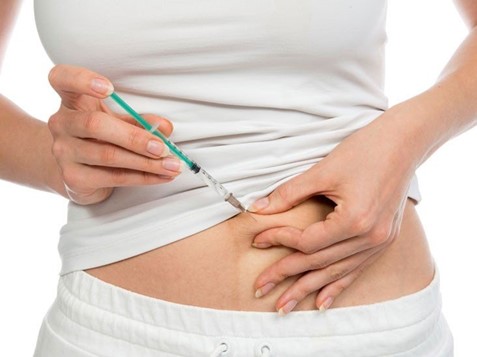What is the usual route for giving an insulin injection?
Intramuscular
Subcutaneous
Intraosseous
Intradermal
The Correct Answer is B
Subcutaneous injection is the usual route for giving insulin because it allows the medication to be absorbed slowly and steadily into the bloodstream. Subcutaneous injection involves inserting a needle into the faty layer of tissue under the skin, usually in the abdomen, upper arm, thigh, or butock.
Intramuscular injection is not the usual route for giving insulin because it may cause rapid and unpredictable absorption of the medication, which can lead to hypoglycemia or hyperglycemia. Intramuscular injection involves inserting a needle into the muscle tissue, usually in the deltoid, vastus lateralis, or ventrogluteal area.
Intraosseous injection is not the usual route for giving insulin because it is reserved for emergency situations when intravenous access is not available. Intraosseous injection involves inserting a needle into the bone marrow, usually in the tibia or humerus.
Intradermal injection is not the usual route for giving insulin because it is mainly used for diagnostic tests, such as tuberculin skin test or allergy test. Intradermal injection involves inserting a needle into the dermis, which is the layer of skin just below the epidermis, usually in the forearm or upper back.

Nursing Test Bank
Naxlex Comprehensive Predictor Exams
Related Questions
Correct Answer is D
Explanation
This action should be taken by the nurse before administering the medication because the use of a trailing zero after a decimal point (5.0 mg) is a common cause of medication errors and should be avoided. A trailing zero may be misread or misinterpreted as a larger dose (50 mg) or omited altogether, resulting in a 10-fold overdose or underdose, respectively. For example, when prescriptions have been writen for "Coumadin 1.0 mg," patients have received 10 mg in error. Therefore, the nurse should clarify the intended dose with the healthcare provider and use the correct notation (5 mg) without a trailing zero.
The other options are not appropriate actions because:
a) Discussing the use of PO (by mouth) with the healthcare provider is not necessary, as PO is a standard route of administration for Haldol (haloperidol) and does not pose a risk of confusion or error.
b) Discussing the use of tid (three times a day) with the healthcare provider is not necessary, as tid is a standard frequency of administration for Haldol and does not pose a risk of confusion or error.
c) Discussing the use of Haldol with the healthcare provider is not relevant to the question, as Haldol is the prescribed medication for the patient who is agitated and does not need to be changed or questioned by the nurse.
Correct Answer is A
Explanation
To calculate the gt/min flow rate, we need to determine the total number of drops and divide it by the total time in minutes.
First, let's convert the volume from liters to milliliters:
1 L = 1000 mL
Next, we need to determine the total number of drops. This can be calculated using the drop factor and the volume of the solution:
Total drops = Volume (mL) * Drop factor
= 1000 mL * 15 gt/mL
= 15000 gt
Now, we need to calculate the flow rate in gt/min. We divide the total drops by the total time in minutes: Flow rate = Total drops / Total time (min)
= 15000 gt / 360 min
≈ 41.67 gt/min (rounded to the nearest whole number)
Therefore, the correct answer is:
a. 41.6 gt/min
Whether you are a student looking to ace your exams or a practicing nurse seeking to enhance your expertise , our nursing education contents will empower you with the confidence and competence to make a difference in the lives of patients and become a respected leader in the healthcare field.
Visit Naxlex, invest in your future and unlock endless possibilities with our unparalleled nursing education contents today
Report Wrong Answer on the Current Question
Do you disagree with the answer? If yes, what is your expected answer? Explain.
Kindly be descriptive with the issue you are facing.
